Sri Lanka - September 2007

Sri Lanka is an island about 20 miles south east of India. My interest in the country came from a famous science fiction writer, Arthur C Clarke, and (somewhat vacuously) from the dramatic visuals in the Duran Duran video 'Save a Prayer'.
Sri Lanka wasn't a great trip for me partly due to being violently sick just a few days after I arrived. Finding a tour to Sri Lanka in the time I had free proved very difficult and I should have taken note of this as a warning. Sometimes, when your plans prove difficult, you have to take note of the warning signs and move on to something else.
I booked a flight to Colombo and a tour with Ceylon Tours. My first warning signs came when, after paying them over $1000 for the tour, they told me that Yala National Park, the place to see leopards and other wildlife, was closed; that my trip was being changed and if I cancelled there would be a charge. Yes, I was annoyed. As the park closes around the same time every year (as I later found out), it would have been helpful if I'd been told before I paid my money.
I'm sorry to say that I just don't understand the way people from the Indian subcontinent think. We often have to deal with the ubiquitous 'indian call centre' that operates in every area of life, from banking to insurance, computer support to holiday bookings, and every interaction is exasperating.
It's also important to remember that Sri Lanka has suffered greatly over the last couple of decades from events of the past.
The British were the first to take control of the whole island of Ceylon in 1815, and the country gained independence in 1948. Under Sinhala nationalism Tamil plantation workers were killed in violent conflict after laws were passed favouring the Sinhalese.
In 1972 Ceylon changed it's name to Sri Lanka and Buddhism made the country's religion, angering Tamils further. The LTTE (Liberation Tigers of Tamil EElam) formed.
In the 1980's Sri Lanka slowly descended into civil war, with the Tamils taking control of the north of the island. In 1986 21 died on an Air Lanka plane at Colombo airport.
In 1993 President Premadasa was killed in LTTE bomb attack; and war raged across the north and west of the country. A Tamil attack on Colombo airport in 2001 destroyed half the national airline's fleet.
In 2002 a ceasefire was agreed, but the country suffered it's worst floods ever in 2003. Worse was still to come. A suicide bomber in July 2004 was followed by terrible destruction in December when the undersea earthquake off Indonesia created a tsunami that killed over 30,000 people in Sri Lanka and swept 3 miles inland. Of course there were arguments over the way the $3 billion of aid was to be shared, and bombing and rioting continued. 64 people died in 2006 in a mine attack on a bus and a suicide bomber killed over 90 soldiers.
In 2007 tourism, according to the BBC, had 'slumped'. So. looking back, I have to ask myself 'what was I thinking'? (since my visit there have been more attacks and more deaths)
I tried not to think about it on the overnight flight out and on arrival in Colombo next morning I found my guide for the tour. I was taken to the Galle Face Hotel, 'offering uncluttered elegance, sophistication and superlative service' and home from home for British science fiction writer Arthur C Clarke. Clarke wrote the final chapters of 3001 at the hotel and is now a resident of Sri Lanka.
In the afternoon I went on a tour of Colombo. Perhaps it was a combination of the grey stormy weather and the long overnight flight but I wasn't overly excited. Here was the first opportunity to visit a shrine of Buddha, with the appropriate payment of course.
After the ubiquitous buffet dinner I went to bed as the next day I was being taken to Anuradhapura.
The trip from Colombo to Anuradhapura was around 130 miles, taking several hours. Anuradhapura is one of the ancient capitals of Sri Lanka and is a UNESCO World Heritage site. Founded in the 4th century BC, it was the capital of the Anuradhapura Kingdom until the beginning of the 11th century AD and is considered sacred to the Buddhist world.
There are many ruins and stupas or dagobas (I haven't quite figured out if the different names have any special significance) at Anuradhapura, including Ruwanwelisaya, Thuparamaya, Jetavanaramaya and Kuttam Pokuna (these names play havoc with my spellchecker!).
The Ruwanwelisaya stupa is one of the largest at Anuradhapura (I think only Jetavanaramaya is taller) and partly because of the size and location I found it difficult to get a favourable photo. Thuparamaya was easier to photograph.
Thuparamaya is considered to be the first dagoba built in Sri Lanka after the introduction of Buddhism. The name Thuparamaya comes from "stupa" and "aramaya" which is a residence for monks. The current construction dates from 1862AD.
Jetavanaramaya is the largest stupa in Sri Lanka at over 400ft high, and part of a sash or belt tied by the Buddha is supposed to be enshrined here.
Kuttam Pokuna is a well preserved example of the Sri Lankan bathing tanks or pools. Built in the 3rd century AD the four entrances are decorated with large solid stone vases carved with lotus buds.
The moonstone is another regular feature of Sri Lankan Buddhist buildings. The moonstone is a semi-circular carved stone, with a ring of flames carved into the outer edge. Within the ring of flames are carved four types of animals; the elephant, horse, lion and bull. Then in turn is a floral pattern, a line of swans, another floral pattern, and a central lotus flower. On the steps another intriguing carving of a dwarf can be found.
Leaving Anuradhapura we passed a man feeding a monitor lizard. Monitors are carnivorous lizards, are quite intelligent and can be extremely strong.
Next morning we visited Mihintale. Mihintale is considered the location where Buddhism was first introduced to the island of Sri Lanka.
There are two stories, one historical and one mythological, that explain the arrival of Buddhism at Mihintale. According to historical sources, in the middle of the third century BC the great Indian Emperor Ashoka had sent his son Mahinda to Sri Lanka to spread the teachings of the Buddha. Mahinda and his group of Buddhist monks were camped upon the sides of Mt Mihintale when King Devanampiya Tissa of Anuradhapura encountered them during a royal hunting expedition. Mahinda spoke to the king of Buddhism and recited the Culahastipadopama and other sutras. The date of this meeting between King Devanampiya Tissa and the Buddhist monk is believed to have been on the full moon of June in the year 247 BC. Soon thereafter the king (and 40,000 inhabitants of Anuradhapura) converted to Buddhism.
An alternate story of the arrival of Buddhism in Sri Lanka tells that the Buddha himself journeyed to the island, on the back of the great winged demigod Garuda, but there is no historical evidence that the Buddha ever visited the island.
The journey to the summit of Meditation Rock is via a stairway of some 1840 steps, some cut roughly from the rock and now smooth and slippery. Also as a Holy place you must remove your shoes for the greater part of the climb. The view from the top is magnificent, You can look down on the large seated Buddha statue and gaze across at the Mahaseya dagoba. The Mahaseya dagoba supposedly contains a single hair of the Buddha and after restoration is now a dazzling white.
After lunch we took a drive to Aukana on the way to Giritale. Aukana is famous for the statue of Buddha, thought to date from the 5th century, although some say the style is closer to the 12th century. It is 39ft high and carved from the rock it remains attached to. The statue depicts Buddha with his right hand in the asisa mudra position, a gesture of blessing, while with his left he gathers up his robe as he prepares to step over the river representing the cycle of rebirth, or samsara.
At Giritale I spent a pleasant evening at the Deer Park hotel in preparation for the next day's adventures.
Polonnaruwa is another UNESCO site and replaced Anuradhapura as the capital in the 11th century after an Indian invasion.
The are a number of interesting ruins, statues and other relics in the area. The remains of Vatadage Temple, where the relic of the tooth of the Buddha was kept, is one of the first you will see. The vatadage is considered to be one of Sri Lanka’s most perfect creations. It is a circular shrine enclosing a small dagoba. Just remember you're not supposed to have your photo taken with your back to the Buddha.
You'll also see some cheeky monkeys among the large stone reclining Buddhas and ruins of royal palaces. They are not especially curious about tourists but are very interested in anything you leave lying around! One curious fellow decided to taste, bite and pull at every part of a local's moped before finding the mirrors and taking time to admire himself.
Nearby is the Potgul Vihara statue. It is considered a superb example of Asian art. The statue is thought to be of King Parakramabahu, although some believe it is more likely to be a scholar. On the top of the statue there is a carving to support this.
We then travelled to Sigiriya. This was where one of the facets of being a tourist started to get me down. The downtown in tourism meant that everywhere you go in Sri Lanka you have people trying to sell you whatever they have on offer. Unlike other places I've visited, where a couple of good natured no thank you's will do, these guys will follow you around and can keep an eye on you for your entire visit, often following me right back to my car. This was made worse by being on a tour alone, there was absolutely nowhere to hide and no other tourists for them to bother.
Arriving at Sigiriya about 7 or 8 people surrounded the car, and there were plenty more 'guides' nearby. I was starting to feel a little unwell, tired and thirsty, although I wasn't sure why.
Making my way with what I thought was a rather expensive guide and trying not to lose my temper with the sellers that wouldn't leave me alone (It's supposed to be extremely rude to shout but I was losing patience) we made our way past the outer moats and up to the rock.
Sigiriya is one of seven UNESCO sites in Sri Lanka and the most popular tourist destination. It is formed from the magma of a long extinct and eroded volcano.
There are steep steps that climb to the mirror wall, with nearly 1,500 pieces of prose and poetry composed by the ancient visitors who flocked to Sigiriya from all over the island. These poems were written between the 7th and 13th centuries. They are said to be Sri Lanka's oldest graffiti.
Just above the mirror wall are the frescos. These paintings of women rising from clouds are known as "the cloud damsels". They are depicted in three quarter profile and have striking diversity in mood and personality, face and body, clothes and make-up.
Originally, there were over 500 paintings drawn across the face of Sigiriya forming a gigantic gallery of paintings. This covered an area almost twice as large as a football field. These paintings may perhaps have been the largest murals ever attempted by man. However, only 23 of these remain.
Moving on up you reach the Lion Gate. The Lion Gate, now simply a massive pair of brick paws ruins, are all that remain of a huge head and fore paws of a lion whose open mouth served as the entrance to the royal palace.
After my visit to Sigiriya I became violently sick and had to retire to my hotel. After a day of feeling weak, dehydrated and miserable I called the airline and flew back to London next day day, cutting my tour of Sri Lanka short.
I'm very pleased I visited Sri Lanka, but perhaps because of my mental and physical state I wasn't as impressed as I'd expected to be. It's not a country I'm thinking of going back to.

A somewhat stormy day seen from the window of my Colombo hotel

The first of many of the statues of Buddha seen on the trip
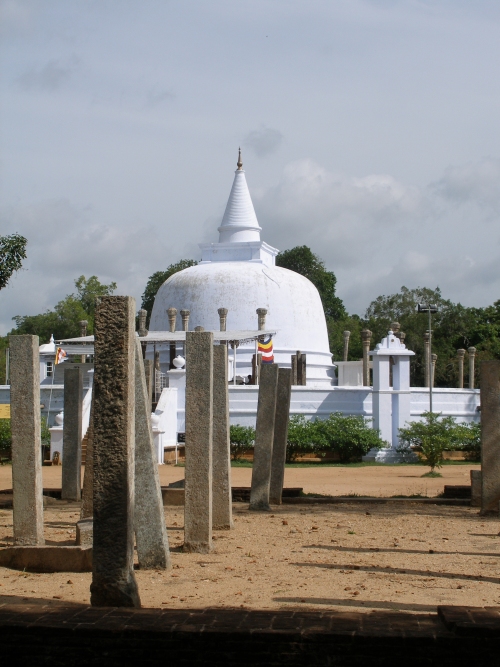
The Thuparamaya stupa at Anuradhapura

The Jetavanaramaya stupa
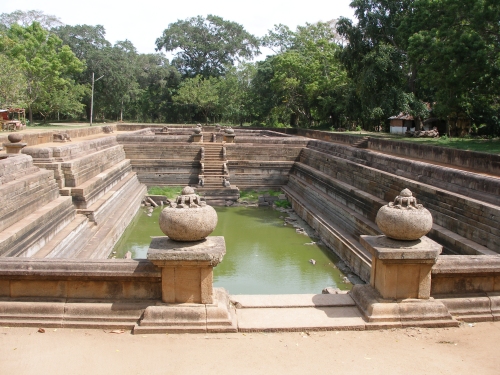
Kuttam Pokuna
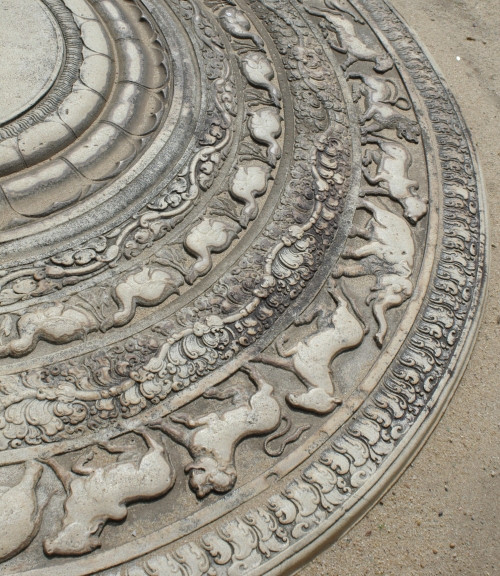
A moonstone showing the ring of flames and animal / floral carvings.
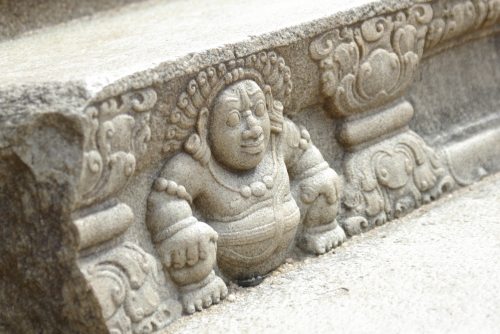
A carving of a dwarf on the steps
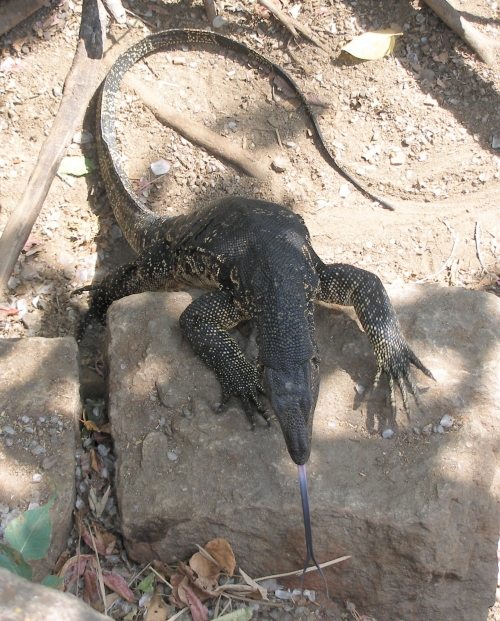
A monitor lizard near Anuradhapura
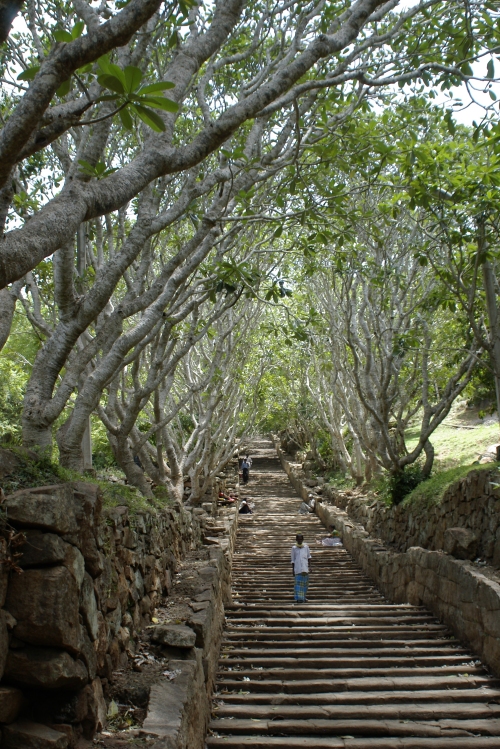
The stairway at Mihintale
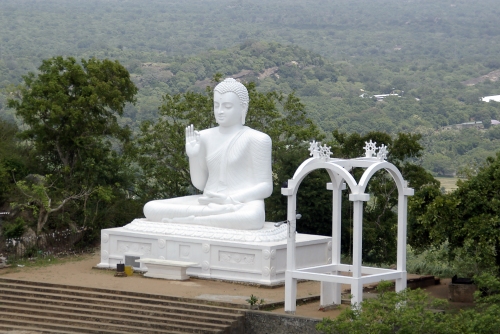
The large statue of Buddha at Mihintale
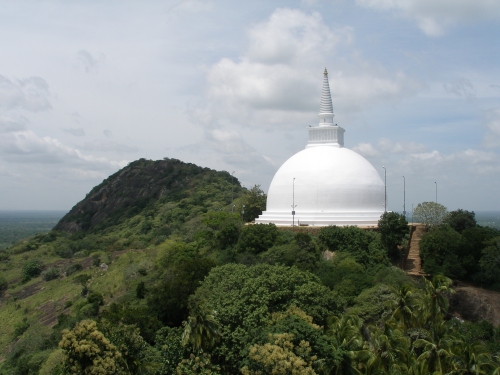
The Mahaseya dagoba
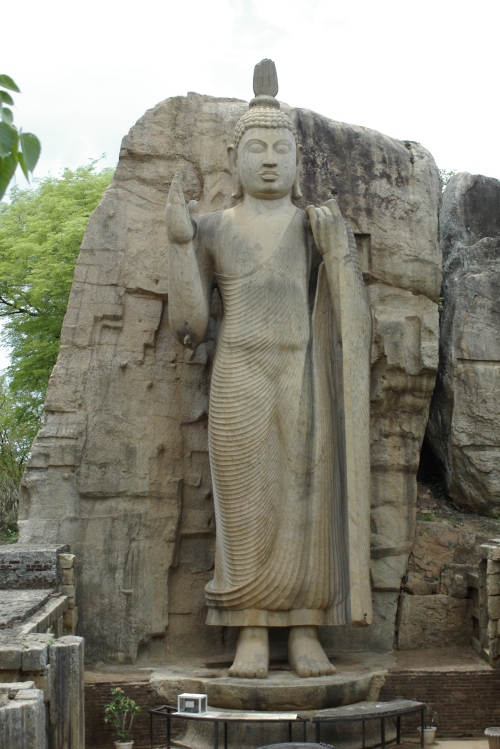
The Aukana Buddha
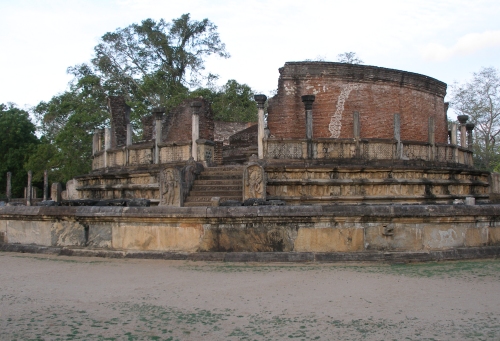
The remains of Vatadage Temple

Posing near the Vatadage Temple
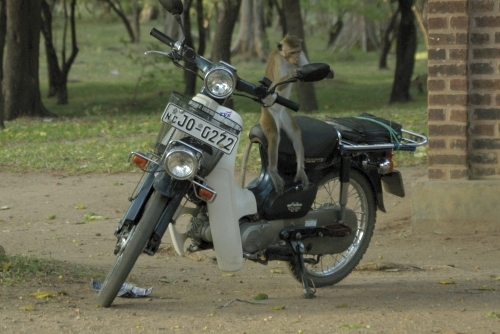
A cheeky monkey considers taking moped lessons
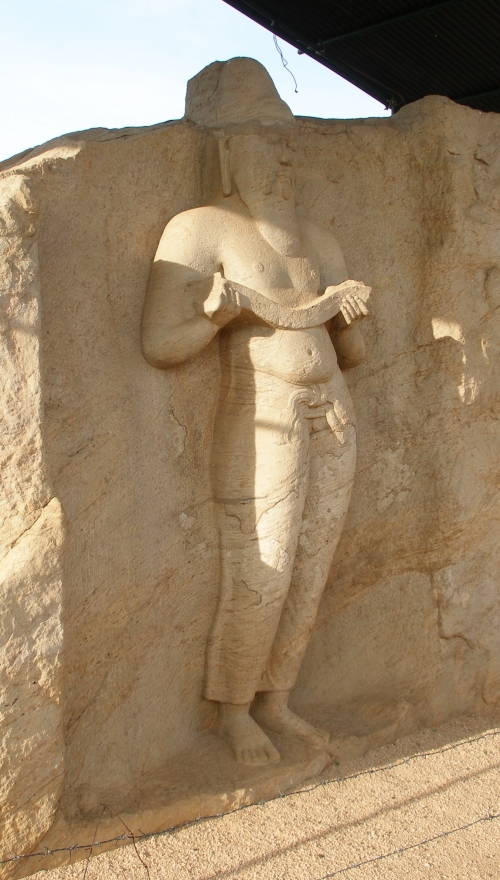
The Potgul Vihara statue
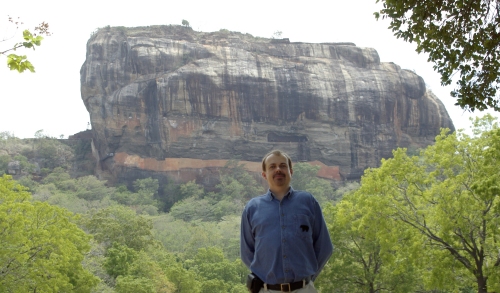
Posing in front of the great Sigiriya rock
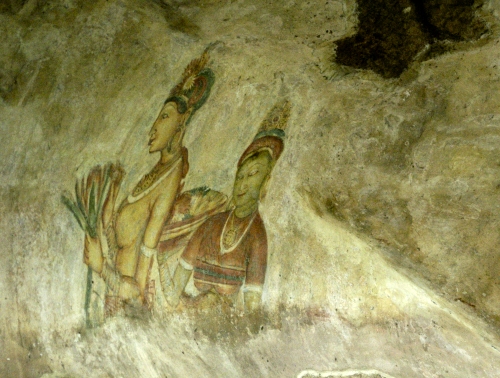
One of the Sigiriya frescos
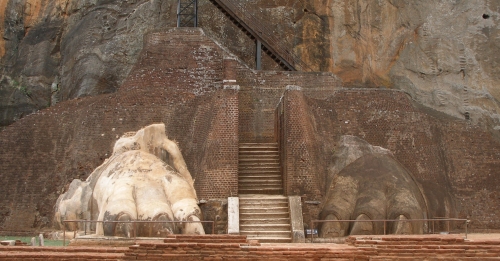
The ruins of the Lion Gate
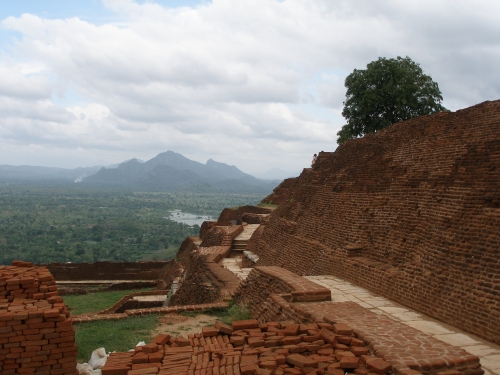
Beyond the Lion Gate to the top of Sigiriya

A view from the top of Sigiriya